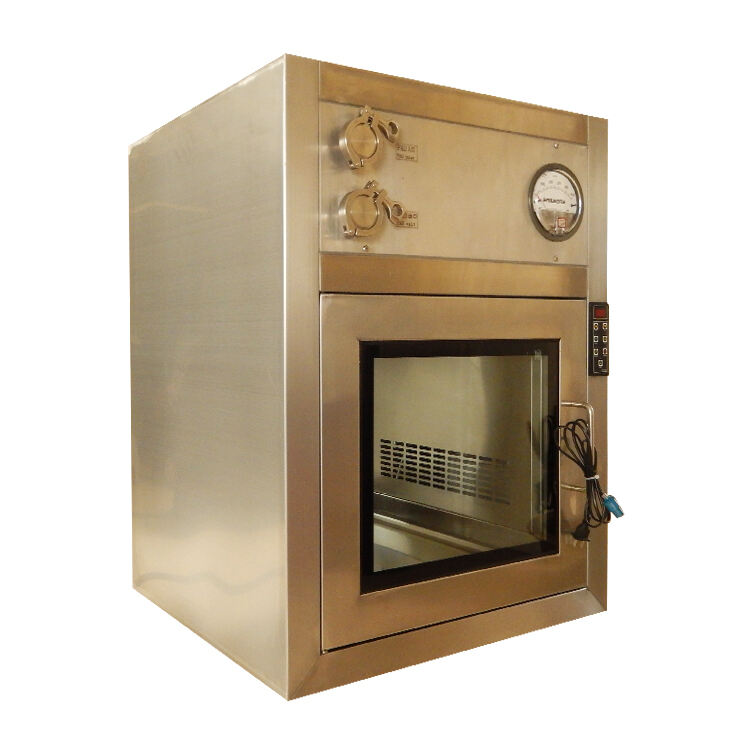Modern İçin Gerekli Malzemeler Geçiş Kutusu Üretme
Geçiş Kutusu temiz oda ortamlarında, farmasötik tesislerde ve laboratuvarlarda kritik bileşenler olarak görev yaparlar ve kontrollü koşulları korurken malzemelerin güvenli bir şekilde aktarılmasını sağlarlar. Geçiş kutusu inşası için uygun malzeme seçimi, performanslarını, dayanıklılıklarını ve sektör standartlarına uyumlarını doğrudan etkiler.
Geçiş kutusu tasarlanırken ve inşa edilirken üreticilerin kimyasal direnç, temizlenebilirlik, dayanıklılık ve sterilizasyon yöntemleriyle uyumluluk gibi çeşitli faktörleri dikkate almaları gerekir. Doğru malzeme seçimi, bu önemli transfer ünitelerinin bütünlüğünü korumasını ve sert düzenleyici gereklilikleri karşılamasını sağlar.
Birincil İnşaat Malzemeleri
Paslanmaz Çelik Bileşenler
Paslanmaz çelik, özellikle 304 ve 316L kaliteleri, geçiş kutusu yapımında altın standart olarak kabul edilir. Bu malzemeler olağanüstü korozyon direnci, dayanıklılık ve kolay temizlenebilirlik sunar. 316L kalite, kimyasal korozyona karşı gelişmiş koruma sağlar ve agresif temizlik maddelerinin rutin olarak kullanıldığı daha zorlu ortamlar için idealdir.
Paslanmaz çeliğin gözeneksiz yapısı bakteri büyümesini ve bulaşmayı önlerken, dayanıklı yapısı uzun vadeli güvenilirliği garanti eder. Üreticiler genellikle iç yüzeyler için elektropolishlenmiş paslanmaz çelik tercih eder çünkü bu işlem temizlenebilirliği artırır ve partikül tutulmasını azaltır.
Cam ve Şeffaf Malzemeler
Isıl işlemden geçirilmiş emniyet camı ve polikarbonat malzemeler, özellikle gözlem pencereleri ve kapılar için geçiş kutusu yapımında önemli rol oynar. Bu malzemeler gerekli darbe direncini ve dayanıklılığı sağlarken berraklıklarını korumalıdır. Sıcaklık kontrollü ortamlarda ısı yalıtımını artırmak ve yoğuşmayı önlemek amacıyla sıklıkla çift camlı paneller kullanılır.
Lamine etme veya özel kaplamalar gibi gelişmiş cam işlemler, UV koruma ve artan kimyasal direnç dahil olmak üzere ek avantajlar sağlayabilir. Cam bileşenlerin kalınlığı, yapısal bütünlüğü sağlamak ve aynı zamanda işletme verimliliğini korumak için dikkatlice hesaplanmalıdır.
İkincil Malzeme Hususları
Conta ve Keçeleri Malzemeleri
Geçiş kutusu yapımında hava sızdırmaz contalar sağlamak için yüksek kaliteli silikon ve EPDM (Etilen Propilen Dien Monomer) contalar esastır. Bu malzemeler, tekrarlanan sıkıştırmaya, temizlik kimyasallarına maruziyete ve zamanla elastik özelliklerini korumaya dayanabilmelidir. Gıda sınıfı silikon, üstün kimyasal direnci ve toksik olmama özelliği nedeniyle ilaç ve gıda işleme uygulamalarında sıklıkla tercih edilir.
Uygun conta malzemelerinin seçilmesi, sıcaklık direnci, sıkıştırma kalıcı deformasyonu ve sterilizasyon yöntemleriyle uyumluluk gibi faktörleri de dikkate alır. Sürekli sızdırmazlık sağluluğunu temin etmek için düzenli muayene ve değişim programları oluşturulmalıdır.
İç Yüzey İşlemleri
Yüzey işlemleri ve kaplamalar, geçiş kutularının işlevselliğini önemli ölçüde etkiler. Elektropolish yüzeyler partikül yapışmasını azaltır ve temizlenmeyi kolaylaştırır; özel antimikrobiyal kaplamalar ise bakteri üremesine karşı ek koruma sağlayabilir. Kritik uygulamalar için yüzey pürüzlülük ortalaması (Ra) değeri genellikle 0,2 ila 0,5 mikrometre arasında olacak şekilde endüstri standartlarını karşılamalıdır.
Gelişmiş yüzey işlemleri, aşınma direncini ve temizlenebilirliği artırmak amacıyla plazma sıpraylama veya fiziksel buhar biriktirme (PVD) kaplamalarını içerebilir. Bu işlemler, amaçlanan temizlik protokolleri ve çalışma koşullarıyla uyum sağlayacak şekilde dikkatlice seçilmelidir.
İzolasyon ve Çevresel Kontrol Malzemeleri
Termal İzolasyon Seçenekleri
Sıcaklık kontrollü geçiş kutularında etkili yalıtım malzemeleri çok önemlidir. Yüksek yoğunluklu poliüretan köpüğü ve mineral yün, yangın güvenliği gereksinimlerini karşılarak mükemmel termal bariyerler sağlar. Yalıtım kalınlığı ve türü, belirli sıcaklık farkı gereksinimlerine ve çalışma koşullarına göre dikkatlice hesaplanmalıdır.
Modern geçiş kutusu yapımında, hassas sıcaklık kontrolü gerektiren uygulamalar için vakumla yalıtımlı panellerin kullanımı yaygındır. Bu gelişmiş malzemeler, ince duvar profillerini korurken üstün izolasyon performansı sunarak iç mekan kullanımını en üst düzeye çıkarır.

Çevresel Bariyer Malzemeleri
Bazı uygulamalar için elektromanyetik kalkanlama ve radyasyon koruması amacıyla özel malzemeler gerekebilir. Kurşun kaplı paneller veya özel kompozitler nükleer tıp tesislerinde radyasyon koruması sağlarken, bakır örgü veya iletken malzemeler hassas elektronik ortamlarda EMI/RFI koruması amacıyla kullanılabilir.
Engel malzemelerinin seçiminde birincil koruma gereksinimlerinin yanı sıra ağırlık sınırlamaları ve montaj metodu gibi ikincil faktörler de dikkate alınmalıdır. Bu malzemelerin uygun şekilde dokümante edilmesi ve test edilmesi, ilgili güvenlik standartlarına uyumu sağlar.
Sıkça Sorulan Sorular
İlaç uygulamaları için geçiş kutusu iç kısımlarında en iyi malzeme nedir?
İlaç uygulamaları için 316L paslanmaz çelik, üstün korozyon direnci, temizlenebilirliği ve agresif temizlik maddeleriyle uyumluluğu nedeniyle genellikle optimal seçimdir. Malzeme, 0,4 mikrometre veya daha düşük Ra değeri elde etmek üzere elektropolish işleminden geçirilmelidir.
Geçiş kutusu yapımında conta malzemeleri ne sıklıkla değiştirilmelidir?
Conta değiştirme aralıkları kullanım sıklığına ve çevresel koşullara bağlıdır ancak tipik olarak 12 ila 24 ay arasında değişir. Üçer aylık periyotlarla düzenli muayene yapılmalı, aşınma, sıkışma deformasyonu veya bozulma belirtileri görüldüğünde değişim planlanmalıdır.
Geçiş kutusu malzemeleri için hangi yüzey kaplaması önerilir?
Çoğu uygulama için Ra değeri 0,2 ile 0,5 mikrometre arasında olan bir yüzey kaplaması önerilir. Yüzeylerin elektropolish yapılması tercih edilir çünkü bu işlem temizlenmeyi en iyi duruma getirir ve partikül tutunumunu azaltır. Spesifik yüzey kaplama gereksinimleri, amaçlanan kullanıma ve mevzuata göre değişebilir.
Geçiş kutusu yapımında paslanmaz çelik yerine alternatif malzemeler kullanılabilir mi?
Alüminyum veya toz kaplı yumuşak çelik gibi alternatifler daha az zorlu uygulamalar için uygun olabilir, ancak paslanmaz çelik kritik ortamlar için tercih edilen malzeme olarak kalmaya devam etmektedir. Alternatif malzemelerin yalnızca kimyasal uyumluluk, dayanıklılık gereksinimleri ve temizlik protokolleri dikkatlice değerlendirildikten sonra göz önünde bulundurulması gerekir.

